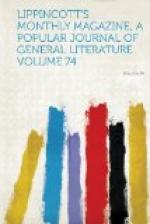But to return to our muttons. Here Captain Herbert pulled up a handsome silvery fish of about a pound weight.
“A whiting!” cried Pecetti, “and the best fish in the river.” Next I hooked a couple of sheepshead, but lost one by the breaking of a hook—a common accident, the jaws of this fish being very powerful. Herbert now got hold of a big one, which played beautifully on his elastic rod, and gave him a long fight and plenty of reel music, but was finally saved, a six-pound sheepshead.
Pecetti, who had waited on us attentively, baiting our hooks and taking off our fish (a service of some danger to a tyro, as the sheepshead is armed with sharp spines), had a hook baited with mullet away astern of the boat. This line was now straightened out by something heavy, which he pulled in, hand over hand, and lifted on board a handsome fish, near two feet long, with darkly mottled sides and shaped like a cod-fish. “That’s a nice grouper,” said he—“ten pound, I think.” This is a percoid, Serranus nigritus of Holbrook, and one of the very best table-fishes of these waters.
We took six or eight more sheepshead, and the captain caught a handsome, active fish of about four pounds weight, resembling the squetegue or weakfish of New York, but having dark spots on the back, like the lake-trout of the Adirondacks. This is the salt-water trout, so called, though it is not a salmonine: it is Otolithus Caroliniensis, the weakfish being Otolithus regalis.
Next I hooked a strong fish which seemed disposed to run under the mangrove roots. “That’s a big grouper,” cried Pecetti. “Keep him away from the roots, or you will lose him.”
I did my best, but he was too strong: the rod bent into a hoop with the strain, but I had to let him run, and he took to his hold under the bank, from whence I was not able to dislodge him, and had to break my line, losing hooks and snood. While this was going on, Herbert, who had put on a mullet bait and let it float down the current, hooked and secured after five minutes’ play a channel bass or redfish of about seven pounds. This is a fish peculiar to the Southern waters, good on the table when in season, which is the spring and summer: in the winter it spawns, and is not so good. When above ten or twelve pounds in weight it is of a brilliant copper-red on back and sides: the smaller ones are of a steel-blue on the back, and iridescent when first caught. It grows to the weight of fifty or sixty pounds, runs in great schools, and in habits and play when hooked resembles the allied species Labrax lineatus, the striped bass. Cuvier named the species Corvina ocellata, from the black spot which it bears near the tail.
The bottom here was rather foul, being covered with old logs and branches of the mangroves, which, being a very heavy wood, had sunk to the bottom and become covered with barnacles and other crustaceae, which attracted the fish to this spot. They bit well, but so did the sand-flies: as soon as the breeze died away they came out from the bushes in clouds, and attacked us so fiercely that we were obliged to quit.




